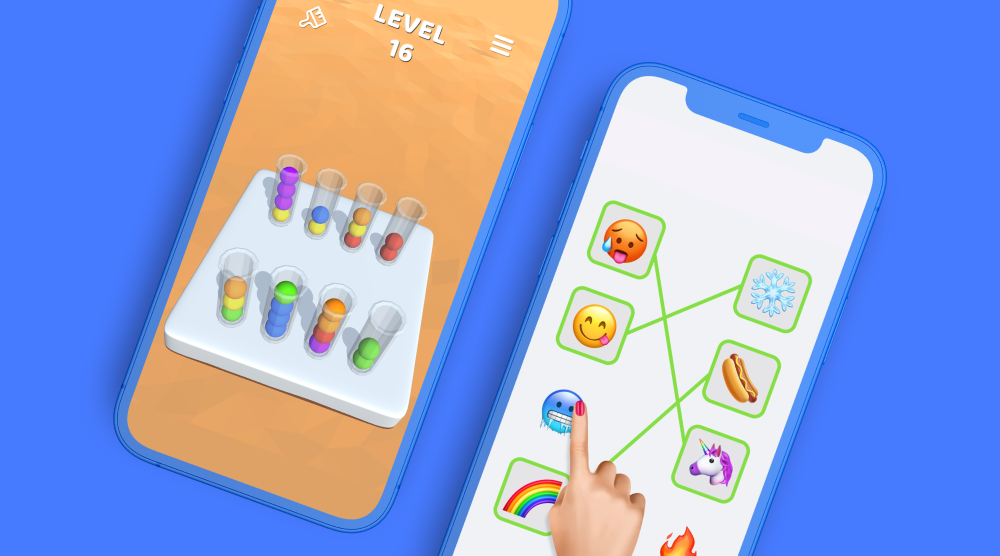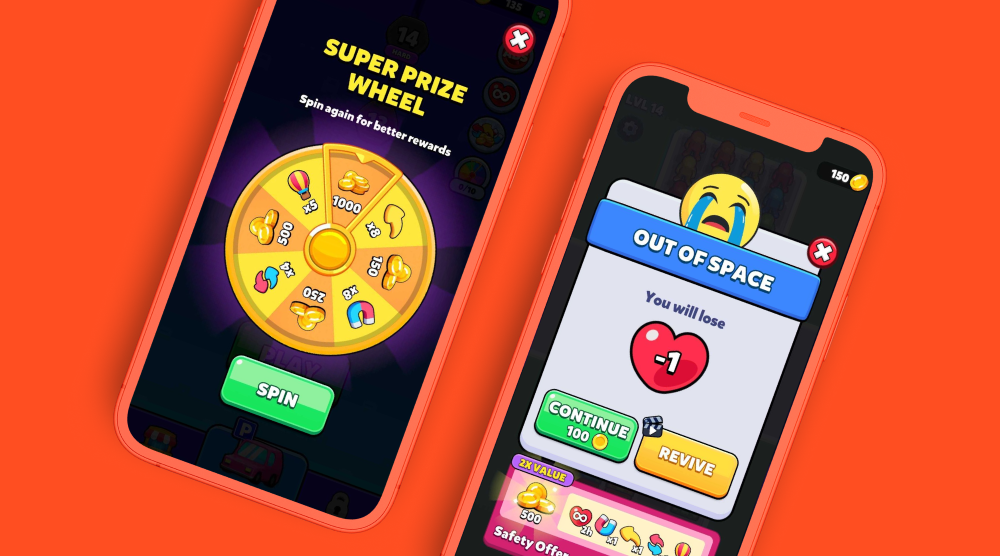It’s hard to think of a more classic game genre than puzzles. Puzzles get the player thinking, and solving them offers a unique satisfaction. It’s for these reasons that puzzles remain one of the best ways to entertain and engage players - and are one of the most popular ways that players choose to spend their time.
Many of the most iconic casual studios, such as King and Playrix, have built massively successful games in the puzzle genre, like Candy Crush and Homescapes. But the success of the genre isn’t confined to casual games - today, 8 of the top 20 hyper and hybrid-casual games are puzzles. Let’s dive into hyper-casual puzzles and what you need to know to create the next puzzle hit.
WTF is a puzzle game
Puzzle games come in many shapes and sizes - there are word puzzles, physics puzzles, sorting puzzles, brain teasers, and math-based puzzles (and that’s just scratching the surface). One thing they all have in common is a focus on problem-solving. They’re all about giving players a challenge to overcome by using their minds.
Just like runners and simulation games, we can break down puzzle level design into three component categories: the frame (in which the game is played in), the objects (the in-game assets that users can interact with), and the conditions (the rules of the game). Unlike runners, there isn’t a one-size fits all core loop, but we can still use these components to understand the structure of puzzle games.
To illustrate, let's examine a classic puzzle game you’ve probably heard of: Tetris. In Tetris, the frame is the area in which geometric forms fall and can be stacked, the falling forms are the objects, and a condition is that if a player completes a line then it disappears and they earn a point.
And you can break down any game in the same way. Swap out the falling forms as objects for static shapes and the condition of creating lines for matches of at least 3 of a kind, and you’ve got the basic structure of a match-3 puzzle game.
What makes a puzzle game hyper or hybrid-casual?
Unlike in other genres, the difference between casual, hyper-casual, and hybrid-casual puzzle games is not about content. For puzzle games, the distinction is less about the depth of gameplay and content (although this can be a factor) and much more about the monetization strategy. This is because the monetization strategy you decide on will inform the pressure points and difficulty of the game, and therefore the type.
Casual puzzle games emphasize in-app purchases (IAP), and so use a separate soft currency and focus on long-term players. As a result, they put significantly more focus on their in-app stores, engaging and rewarding users, and optimizing pressure point locations (pressure points are spikes in difficulty).
In contrast, hyper and hybrid-casual puzzle games monetize from a mix of ads and IAP and so have a greater focus on ad placements and simple mechanics for mid-term engagement.
Hybrid-casual puzzle games monetize with a 30/70 to 50/50 split between IAA and IAP. Ads are used sparingly, often only during fail windows, and difficulty is higher to motivate players towards IAP.
On the other hand, hyper-casual puzzle games put a much greater emphasis on ads and have a split closer to 80/20 of ads and IAP - so, they’ll be more likely to use ad formats like interstitials. Hyper-casual puzzle games are also often less difficult than their casual and hybrid-casual counterparts.
Here are some examples of puzzles with strong marketability we’ve published that you can use for reference: Emoji Puzzle! and Sort It 3D.
Ideation for puzzle games
If you’re looking for new ideas for a puzzle game, then the same resources shared in How to design a hit gate runner: the basics and best practices are a great place to start. Other resources that are relevant for puzzle game ideation include board games and puzzle books - pick up one the next time you’re in an airport, you’ll be surprised how many great ideas for games are inside.
Once you’ve got an idea of what kind of puzzle games you want to create, test it out on paper and get your friends to play. No use in wasting time developing a game to concept test when you can do it with a ballpoint pen and some blank pages.
If you’re thinking of going into match-3 or classic merge board games, remember you’re facing off against titans so try and come up with something as original as possible.
Determining the correct difficulty level for puzzle games
Difficulty in puzzle games depends on the kind of game that you want to create - what’s true for word puzzles won’t necessarily apply to sorting puzzles. But, there are a few rules of thumb that are good to know.
1. Try not to depend on time limitations. While a quick hack in puzzle games to raise difficulty is to put the player on the clock, often this can work against your aims. Successful puzzles empower the player while challenging them, making them feel smarter for solving it. Time-related difficulty can cause frustration that has nothing to do with cracking a tough problem, instead making the player fail due to their reaction time - and causing some players to churn.
2. Hyper and hybrid-casual puzzles generally should have a smooth onboarding - the player should be able to complete the puzzle in the time it takes to wait for a bus. The idea is to keep gameplay snackable and succinct. Difficulty should be raised, but slowly and incrementally, with plenty of time for the player to get used to the increase.
3. Use the difficulty loop to add new mechanics and increase difficulty. The difficulty loop is a closed system (meaning it should be self-sustaining) used to introduce complexity to increase difficulty, starting at the implementation of a new mechanic. This implementation should be easy enough that the player doesn’t fail easily and is focused on teaching the player about the mechanic and how to use it. Next, after the user has had a few levels to try out the new mechanic, test them with a harder level that utilizes the mechanic. Once completed, give the player a breather, an easier level to quickly complete, for a break. Then raise the difficulty to a static level below the test difficulty but harder than the breather - they should be comfortable enough now with the mechanic. Repeat with a new mechanic to keep growing your game.
Check out this blog to dive deeper into difficulty curves: Difficulty curves - it’s not that hard.
Creative trends and tips
Just like other hyper and hybrid-casual genres, it’s super important that your puzzle game has strong marketability - your creatives are make or break for your game. You should aim for a CPI <$1 during the testing phase, which you should look to grow to around $2 during scale.
The trick to puzzle creatives is communicating what your game is about in as little time as possible. Players should understand what the core mechanic of your game is in under 5 seconds, so jumping straight to gameplay is important. Don’t be afraid of simplifying your gameplay in your creatives to accomplish this. Sound effects can also help here, getting across what your game is about with sound clues (exploding sound effects for bricks breaking etc.)
Popular creative trends include things like fail scenarios where the mistake is obvious so users want to try it themselves to get it right, an IQ test format, progress bars filling up as the puzzle is completed, and ASMR elements. For ASMR themed creatives, we recommend using soothing sound effects to showcase your game as a relaxing experience. More difficult to implement, but also trending, is 3D as a mechanic like with a Rubix cube.
One of the biggest mistakes we see puzzle developers make is overestimating the ease of their game. It’s a pitfall unique to puzzle games, since developers already know the answer to their puzzles. To them the solution might seem obvious and so they assume it will be to others too. The fix is easy: get your friends and family to play your game and provide feedback. The bigger your sample size, the better you’ll be able to understand your game’s difficulty.
Another common mistake is adding too many mechanics too soon. If players are offered too many mechanics at once, particularly early in the game, they’ll be overwhelmed. Rather, introduce one mechanic at a time, starting with your strongest and most compelling.
Lastly, make your gameplay scalable. In this context that means don’t become overly reliant on a single mechanic. Doing so limits your ability to keep adding levels in the long term and can lead to idea burnout. Rather, add new mechanics periodically so that you can take your game in new directions. This will allow you to more easily iterate, keep the game interesting, and come up with new levels as your game grows.
Let’s get started
These tips are a great starting point for your next puzzle game. Use them, and you’ll skip a ton of the mistakes and time sinks many devs have when creating their games. We can’t wait to see what you come up with.
Let's put these tips to good use
Publish your game with Supersonic



